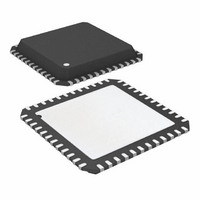AD9511BCPZ Analog Devices Inc, AD9511BCPZ Datasheet - Page 40

AD9511BCPZ
Manufacturer Part Number
AD9511BCPZ
Description
IC CLOCK DIST 5OUT PLL 48LFCSP
Manufacturer
Analog Devices Inc
Type
Fanout Buffer (Distribution), Divider, PLLr
Datasheet
1.AD9511BCPZ.pdf
(60 pages)
Specifications of AD9511BCPZ
Number Of Circuits
1
Ratio - Input:output
2:5
Differential - Input:output
Yes/Yes
Input
Clock
Output
CMOS, LVDS, LVPECL
Frequency - Max
1.2GHz
Voltage - Supply
3.135 V ~ 3.465 V
Operating Temperature
-40°C ~ 85°C
Mounting Type
Surface Mount
Package / Case
48-LFCSP
Frequency-max
1.2GHz
Clock Ic Type
Clock Distribution
Ic Interface Type
Serial
Frequency
1.2GHz
No. Of Outputs
5
No. Of Multipliers / Dividers
5
Supply Voltage Range
3.135V To 3.465V
Lead Free Status / RoHS Status
Lead free / RoHS Compliant
For Use With
AD9511/PCB - BOARD EVAL CLOCK DISTR 48LFCSPAD9511-VCO/PCB - BOARD EVAL CLOCK DISTR 48LFCSP
Lead Free Status / RoHS Status
Lead free / RoHS Compliant, Lead free / RoHS Compliant
Available stocks
Company
Part Number
Manufacturer
Quantity
Price
Company:
Part Number:
AD9511BCPZ
Manufacturer:
ADI
Quantity:
139
Part Number:
AD9511BCPZ
Manufacturer:
ADI/亚德诺
Quantity:
20 000
Part Number:
AD9511BCPZ-REEL7
Manufacturer:
ADI/亚德诺
Quantity:
20 000
AD9511
RESET MODES
The AD9511 has several ways to force the chip into a reset
condition.
Power-On Reset—Start-Up Conditions when VS is
Applied
A power-on reset (POR) is issued when the VS power supply is
turned on. This initializes the chip to the power-on conditions
that are determined by the default register settings. These are
indicated in the default value column of Table 23.
Asynchronous Reset via the FUNCTION Pin
As mentioned in the FUNCTION Pin section, a hard reset,
RESETB: 58h<6:5> = 00b (Default), restores the chip to the
default settings.
Soft Reset via the Serial Port
The serial control port allows a soft reset by writing to
Register 00h<5> = 1b. When this bit is set, the chip executes a
soft reset. This restores the default values to the internal
registers, except for Register 00h itself.
This bit is not self-clearing. The bit must be written to
00h<5> = 0b for the operation of the part to continue.
SINGLE-CHIP SYNCHRONIZATION
SYNCB—Hardware SYNC
The AD9511 clocks can be synchronized to each other at any
time. The outputs of the clocks are forced into a known state
with respect to each other and then allowed to continue
clocking from that state in synchronicity. Before a
synchronization is done, the FUNCTION Pin must be set as the
SYNCB: 58h<6:5> = 01b input (58h<6:5> = 01b).
Synchronization is done by forcing the FUNCTION pin low,
creating a SYNCB signal and then releasing it.
See the SYNCB: 58h<6:5> = 01b section for a more detailed
description of what happens when the SYNCB: 58h<6:5> = 01b
signal is issued.
Soft SYNC—Register 58h<2>
A soft SYNC may be issued by means of a bit in the Register
58h<2>. This soft SYNC works the same as the SYNCB, except
that the polarity is reversed. A 1 written to this bit forces the
clock outputs into a known state with respect to each other.
When a 0 is subsequently written to this bit, the clock outputs
continue clocking from that state in synchronicity.
MULTICHIP SYNCHRONIZATION
The AD9511 provides a means of synchronizing two or more
AD9511s. This is not an active synchronization; it requires user
monitoring and action. The arrangement of two AD9511s to be
synchronized is shown in Figure 43.
Rev. A | Page 40 of 60
Synchronization of two or more AD9511s requires a fast clock
and a slow clock. The fast clock can be up to 1 GHz and may be
the clock driving the master AD9511 CLK1 input or one of the
outputs of the master. The fast clock acts as the input to the
distribution section of the slave AD9511 and is connected to its
CLK1 input. The PLL may be used on the master, but the slave
PLL is not used.
The slow clock is the clock that is synchronized across the two
chips. This clock must be no faster than one-fourth of the fast
clock, and no greater than 250 MHz. The slow clock is taken
from one of the outputs of the master AD9511 and acts as the
REFIN (or CLK2) input to the slave AD9511. One of the
outputs of the slave must provide this same frequency back to
the CLK2 (or REFIN) input of the slave.
Multichip synchronization is enabled by writing to Register
58h<0> = 1b on the slave AD9511. When this bit is set, the
STATUS pin becomes the output for the SYNC signal. A low
signal indicates an in-sync condition, and a high indicates an
out-of-sync condition.
Register 58h<1> selects the number of fast clock cycles that are
the maximum separation of the slow clock edges that are
considered synchronized. When 58h<1> = 0b (default), the
slow clock edges must be coincident within 1 to 1.5 high speed
clock cycles. If the coincidence of the slow clock edges is closer
than this amount, the SYNC flag stays low. If the coincidence of
the slow clock edges is greater than this amount, the SYNC flag
is set high. When Register 58h<1> = 1b, the amount of
coincidence required is 0.5 fast clock cycles to 1 fast clock
cycles.
Whenever the SYNC flag is set (high), indicating an out-of-sync
condition, a SYNCB signal applied simultaneously at the
FUNCTION pins of both AD9511s brings the slow clocks into
synchronization.
SYNCB
FUNCTION
(SYNCB)
FUNCTION
CLK1
(SYNCB)
Figure 43. Multichip Synchronization
FAST CLOCK
<1GHz
AD9511
SLAVE
AD9511
MASTER
CLK2
DETECT
SLOW CLOCK
SYNC
FAST CLOCK
<250MHz
REFIN
<1GHz
<250MHz
CLOCK
SLOW
OUTN
OUTM
F
SYNC
OUTY
STATUS
(SYNC)
F
SYNC














